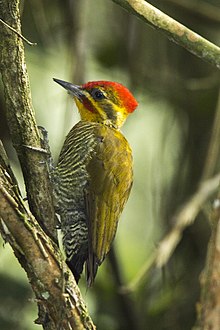| Yellow-browed woodpecker | |
|---|---|

| |
| Male in Espírito Santo State, Brazil | |
| Conservation status | |
 Near Threatened (IUCN 3.1) | |
| Scientific classification | |
| Domain: | Eukaryota |
| Kingdom: | Animalia |
| Phylum: | Chordata |
| Class: | Aves |
| Order: | Piciformes |
| Family: | Picidae |
| Genus: | Piculus |
| Species: | P. aurulentus |
| Binomial name | |
| Piculus aurulentus (Temminck, 1821) | |

| |
The yellow-browed woodpecker (Piculus aurulentus), also known as the white-browed woodpecker, is a Near Threatened species of bird in the woodpecker family Picidae. It is found in Argentina, Brazil, Paraguay, and Uruguay.
Taxonomy and systematics
Some authors treat the yellow-browed woodpecker and the golden-green woodpecker (P. chrysochloros) as a superspecies. The species is monotypic.

Description
The yellow-browed woodpecker is 21 to 22 cm (8.3 to 8.7 in) long and weighs 22 to 68 g (0.78 to 2.4 oz). Males and females have the same plumage except on their heads. Males are red from forehead to nape, have a narrow yellowish white supercilium, are dark olive green around the eye and onto the side of the neck, and successively below that a pale yellow stripe and a red malar band. Their chin and throat are pale golden. The female has an olive forehead and crown and much less red at the malar. Adults have olive green upperparts. Their flight feathers are dark brown with greenish edges and dark cinnamon-rufous on the inner webs. Their tail is blackish. Their underparts are whitish with wide dark olive bars. Their medium-length beak is blackish gray with a paler base on the mandible, their iris chestnut-brown, and the legs greenish gray. Juveniles are generally duller than adults and have less well defined barring on their underparts.
Distribution and habitat
The yellow-browed woodpecker is found from Brazil's São Paulo state south through eastern Paraguay and northern Uruguay into northeastern Argentina. It inhabits the interior and edges of humid mature montane forest, dense secondary forest and woodland, and humid lowland forest. In elevation it ranges between 750 and 2,000 m (2,500 and 6,600 ft) in Brazil and generally lower in the other countries.
Behavior
Movement
As far as is known, the yellow-browed woodpecker is a year-round resident throughout its range.
Feeding
The yellow-browed woodpecker mostly forages in the forest's middle level, by itself or in pairs. It commonly feeds by gleaning and pecking to reach prey. Its diet has not been studied in detail but is known to include ants and their eggs.
Breeding
The yellow-browed woodpecker's breeding season is not well defined but appears to include August to November. It tends to excavate its nest cavity high in a tree.The clutch size, incubation period, time to fledging, and details of parental care are not known.
|
Songs and calls Listen to yellow-browed woodpecker on xeno-canto |
Vocal and non-vocal sounds
The yellow-browed woodpecker's song is a "slow or hurried series of 7-15 high 'wuh' notes." It drums with "rapid, regular rolls."
Status
The IUCN has assessed the yellow-browed woodpecker as Near Threatened. It has a somewhat restricted range and an unknown population size that is believed to be decreasing. Much of its original habitat has been cleared for cultivation and pasture and the conversion continues. "Rather uncommon; apparently shy in nature, and not often seen."
References
- ^ BirdLife International (2017). "Yellow-browed Woodpecker Piculus aurulentus". IUCN Red List of Threatened Species. 2017: e.T22681246A112128085. doi:10.2305/IUCN.UK.2017-1.RLTS.T22681246A112128085.en. Retrieved 27 January 2023.
- ^ Gill, F.; Donsker, D.; Rasmussen, P., eds. (August 2022). "Woodpeckers". IOC World Bird List. v 12.2. Retrieved January 9, 2023.
- Remsen, J. V., Jr., J. I. Areta, E. Bonaccorso, S. Claramunt, A. Jaramillo, D. F. Lane, J. F. Pacheco, M. B. Robbins, F. G. Stiles, and K. J. Zimmer. Version 24 July 2022. Species Lists of Birds for South American Countries and Territories. https://www.museum.lsu.edu/~Remsen/SACCCountryLists.htm retrieved July 24, 2022
- Remsen, J. V., Jr., J. I. Areta, E. Bonaccorso, S. Claramunt, A. Jaramillo, D. F. Lane, J. F. Pacheco, M. B. Robbins, F. G. Stiles, and K. J. Zimmer. Version 24 July 2022. A classification of the bird species of South America. American Ornithological Society. https://www.museum.lsu.edu/~Remsen/SACCBaseline.htm retrieved July 24, 2022
- ^ Winkler, H., D. A. Christie, and A. Bonan (2020). White-browed Woodpecker (Piculus aurulentus), version 1.0. In Birds of the World (J. del Hoyo, A. Elliott, J. Sargatal, D. A. Christie, and E. de Juana, Editors). Cornell Lab of Ornithology, Ithaca, NY, USA. https://doi.org/10.2173/bow.whbwoo7.01 retrieved January 27, 2023
- Ridgely, Robert S.; Greenfield, Paul J. (2001). The Birds of Ecuador: Field Guide. Vol. II. Ithaca: Cornell University Press. p. 192. ISBN 978-0-8014-8721-7.
| Taxon identifiers | |
|---|---|
| Piculus aurulentus |
|
| Picus aurulentus | |
